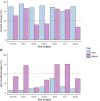Uncertainty monitoring in Eurasian jays (Garrulus glandarius)
- PMID: 40372593
- PMCID: PMC12081489
- DOI: 10.1007/s10071-025-01960-3
Uncertainty monitoring in Eurasian jays (Garrulus glandarius)
Abstract
Metacognition- namely the capacity to reflect on one's own cognitive processes - provides animals with numerous evolutionary advantages. Metacognition abilities encompass enhanced decision-making in uncertain situations, more efficient resource management, error detection and correction, and improved problem-solving skills. Here, we investigate how Eurasian jays, Garrulus glandarius, monitor uncertainty through a working memory food-retrieval task. In this task, a desirable food item is hidden under one of two cups, which are then shuffled either once (easy treatment) or several times (difficult treatment). The jays then choose to either engage in locating the food or opt out by selecting a third cup that offers a less preferred food reward. Our findings reveal that the difficulty of the task significantly influenced the jays' choice, with a higher tendency to opt out during difficult trials. Individual performance analysis revealed that when jays that typically opted out of difficult trials chose to engage instead, they exhibited significant accuracy. This suggests their decisions were guided by a confidence assessment of their knowledge. Overall, our study indicates that Eurasian jays possess metacognitive abilities that enable them to evaluate their own certainty and make strategic decisions based on perceived task difficulty and confidence in their knowledge. These capabilities likely confer advantages in natural settings, such as caching behaviours, allowing jays to make well-informed decisions about when to store or retrieve food based on environmental cues and internal assessments of uncertainty.
Keywords: Avian cognition; Eurasian jays; Individual differences; Metacognition; Self-awareness; Uncertainty monitoring.
© 2025. The Author(s).
Conflict of interest statement
Declarations. Competing interests: The authors declare no competing interests.
Figures






Similar articles
-
Exclusion in corvids: the performance of food-caching Eurasian jays (Garrulus glandarius).J Comp Psychol. 2013 Nov;127(4):428-35. doi: 10.1037/a0032010. Epub 2013 May 13. J Comp Psychol. 2013. PMID: 23668696
-
Hint-seeking behaviour of western scrub-jays in a metacognition task.Anim Cogn. 2016 Jan;19(1):53-64. doi: 10.1007/s10071-015-0912-y. Epub 2015 Aug 13. Anim Cogn. 2016. PMID: 26267805
-
Little evidence that Eurasian jays protect their caches by responding to cues about a conspecific's desire and visual perspective.Elife. 2021 Sep 10;10:e69647. doi: 10.7554/eLife.69647. Elife. 2021. PMID: 34505575 Free PMC article.
-
Metacognition and Confidence: A Review and Synthesis.Annu Rev Psychol. 2024 Jan 18;75:241-268. doi: 10.1146/annurev-psych-022423-032425. Epub 2023 Sep 18. Annu Rev Psychol. 2024. PMID: 37722748 Review.
-
[Characteristics and impact of metacognitive deficits in schizophrenia].Encephale. 2013 Apr;39(2):123-9. doi: 10.1016/j.encep.2012.01.009. Epub 2012 Dec 6. Encephale. 2013. PMID: 23219408 Review. French.
References
-
- Bell AM (2005) Behavioural differences between individuals and two populations of stickleback (Gasterosteus aculeatus). J Evol Biol 18(2):464–473. 10.1111/j.1420-9101.2004.00817.x - PubMed
-
- Ciacci F, Mayerhoff S, De Petrillo F, Gastaldi S, Brosnan SF, Addessi E (2023) State-dependent risky choices in primates: variation in energy budget does not affect tufted capuchin monkeys’ (Sapajus spp.) risky choices. Am J Primatol 85(10):e23542. 10.1002/ajp.23542 - PubMed
MeSH terms
LinkOut - more resources
Full Text Sources

